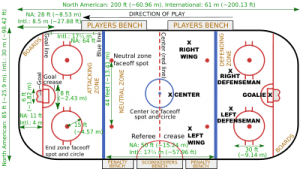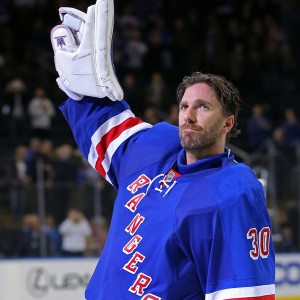Hockey fans rejoice: it’s finally October, and hockey is right around the corner.
For most of you, that means donning your favorite jersey and cheering on your team at the arena or in your living room. But for some, hockey season means listening to your significant other, child, roommates or friends ask endless questions like “How many innings are there in a hockey game?” or, “When is halftime?”
For many hockey fans, this is an extremely depressing experience. You love hockey, but instead of enjoying your favorite pastime with you, your loved ones are asking questions that make you want to throw them on the ice with Zdeno Chara.
This season, instead of pausing every five minutes to explain icing or that no, you’re not seeing double, there actually are two Sedins, direct your hockey rookies to this beginner’s guide to becoming an NHL fan. It’ll answer all those basic questions you’re sick of hearing and make sure you can enjoy your favorite game without hearing the words “Is that offsides?” every time the whistle blows.
The Basics
1. NHL Divisions and Teams
- There were six original teams in the NHL. They were the Detroit Red Wings, Boston Bruins, New York Rangers, Toronto Maples Leafs, Montreal Canadiens and Chicago Blackhawks.
- There are currently 30 teams in the National Hockey League: 23 in the United States and 7 in Canada.
- There are two conferences: the Western Conference and the Eastern Conference.
- Each conference has two divisions. In the Western Conference, there are the Pacific and Central Divisions. In the Eastern, there are the Metropolitan and Atlantic Divisions.
- For a complete list of teams in each division, click here.
2. The Rink

A hockey rink is divided into three parts: the defending zone, the neutral zone and the offensive/attacking zone, as depicted in the diagram to the right.
An official NHL rink is 200 feet long and 85 feet across. There are two blue lines, one red line, two goal creases and five face-off circles. We’ll get in to how those come in to play a little later.
3. The Rules
Just like any other sport, hockey has a set of rules that dictate what players can and cannot do. There are many, many rules in hockey, but these are the most basic, and the ones you’ll need to know at the start. If you wish to study hockey rules more in-depth, click here.
- A hockey game has three periods and lasts a total of 60 minutes. Each individual period lasts 20 minutes, with a 20-minute intermission after the first and second periods.
- If a game is tied at the end of the 60 minutes, the teams will go into overtime.
- Icing: this is one of the most confusing rules in hockey for many people, but it’s an important aspect of the game. Icing happens when a player shoots, dumps or passes the puck down the entire length of the ice, all the way past the opposing team’s goal line. The puck must pass the center red line and the opposing goal line untouched in order for icing to occur. A linesman will then enforce icing and play will stop. Icing is not a penalty; it just calls for a stop in play that results in a face-off in the offending team’s zone.
- Offsides: This is another concept that is difficult for many hockey fans to understand, but offsides is actually a fairly simple concept to understand. The rule simply means an attacking player must not precede the puck into the attacking zone. In even simpler terms, a player heading into the attacking zone needs to make sure the puck is inside the attacking zone before he is. The outcome of offsides is the same as icing: the linesman will blow the whistle and play will stop resulting in a neutral zone face-off.
4. Penalties
Penalties, like rules, keep the players from doing whatever they want. They are:
- Butt ending: When a player jabs another player with the top of his stick.
- Checking from behind: When a player hits another player from behind when he cannot defend himself.
- Cross Checking: When a player checks another player by holding his stick with both hands.
- Elbowing: When a player uses his elbow to jab at another player.
- Fighting: Occurs when a player drops his gloves to fight with an opponent.
- Hooking: When a player hinders an opponent from moving by “hooking” him with his stick.
- Interference: Occurs when a player intentionally interferes with the progress of an opposing player who does not possess the puck.
- Kneeing: Same as elbowing, but with the knee.
- Roughing: This penalty is basically a less severe form of fighting, which usually occurs when one player punches/strikes another, but it is not deemed severe enough for a major penalty.
- Slashing: When a player hits another player with his stick, interfering with his movement.
- Spearing: When a player attempts to “spear” his opponent with the blade of his stick.
- Tripping: Occurs when a player uses any part of his body and/or stick to trip his opponent.
In hockey, there are three kinds of penalties: major, minor and misconduct. The more severe the penalty, the more severe the punishment.
- A minor penalty is the least severe of the penalties. It means the offending player has committed one of the penalties listed above and is required to sit in the penalty box for two minutes. If the penalty drew blood, it becomes four minutes in length. This results in a power play for the opposing team, in which they have five players on the ice and the other team has four. If the team with the man advantage scores during the penalty time, the penalty expires.
- A major penalty essentially occurs when a player commits a more severe version of a minor penalty. Fighting is an exception – it is always a major penalty. A major penalty is five minutes in length, and cannot end early, even if the team with the power play scores.
- A misconduct is the most severe form of penalty. It results in penalty period in which the offending player must sit in the box for 10 minutes. A misconduct penalty is commonly accompanied by a two-minute minor penalty.
- There is also a game misconduct, which means a player or coach will be ejected from the remainder of the game.
5. The Positions
There are five positions in hockey, each with a different responsibility throughout the game. Players typically do not switch positions, unless their team is lacking a player in that specific department. The positions are as follows:
- Goaltender: The goaltender, sometimes called the goalie or net minder, is responsible for preventing the opposing team from scoring. He is the team’s last defense. Many people consider the goaltender to be the most important player on the team. Carey Price, Henrik Lundqvist, Pekka Rinne and Tuukka Rask are some of the most well-known NHL goaltenders.
- Defensemen: When a team is at full strength, it has two defensemen on the ice. These players are also responsible for keeping the opposing team from scoring. They are commonly called defencemen, D, D-men or blue liners, because of their tendency to stay near the blue line. Some prominent NHL defensemen are P.K. Subban, Erik Karlsson, Brent Burns and Ryan Suter.

Henrik Lundqvist is the goaltender for the New York Rangers. (Adam Hunger-USA TODAY Sports)
- Center: The center is a forward position. He is responsible for taking face-offs, passing and keeping his teammates organized in both the defending and attacking zones. He is also expected to have a good shot and be able to provide his team with offense. Notable NHL centers include Sidney Crosby, Steven Stamkos and John Tavares.
- Left Wing: The left wing is also a forward. He covers the left side of the ice and is responsible for providing offense. Left wings also need to be able to dig the puck out of the corner and play in front of the goalie’s net. Some well-known left wingers are Alex Ovechkin, Jamie Benn and Rick Nash.
- Right Wing: A right wing ultimately serves the same role as the left wing, except that he is responsible for covering the right side of ice. They need to be good at passing and controlling the puck. Vladimir Tarasenko, Nikita Kucherov and Jakub Voracek are right wings.
Each team typically has one goalie, six defensemen, four left wings, four right wings and four centers playing during any given game.
Well ladies and gentlemen, you are now on your way to becoming well-educated hockey fans. You now know the NHL basics and will no longer have to ask questions like “What is icing?” Congratulations! Welcome to the wonderful world of NHL hockey.